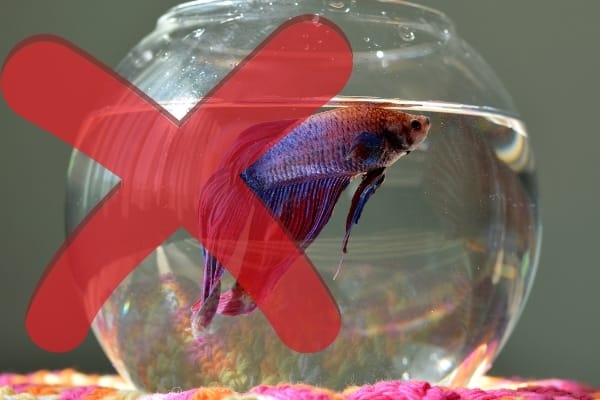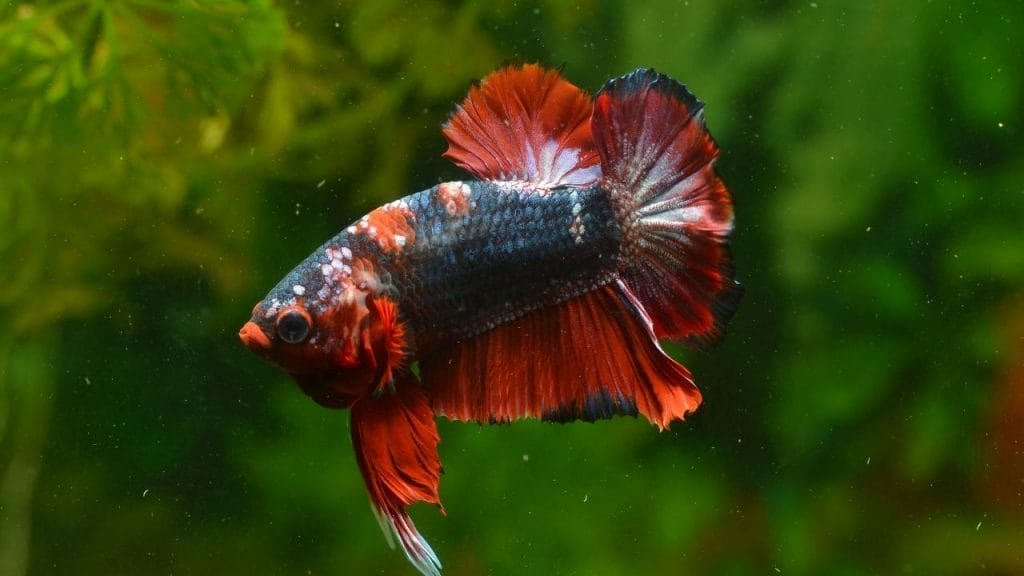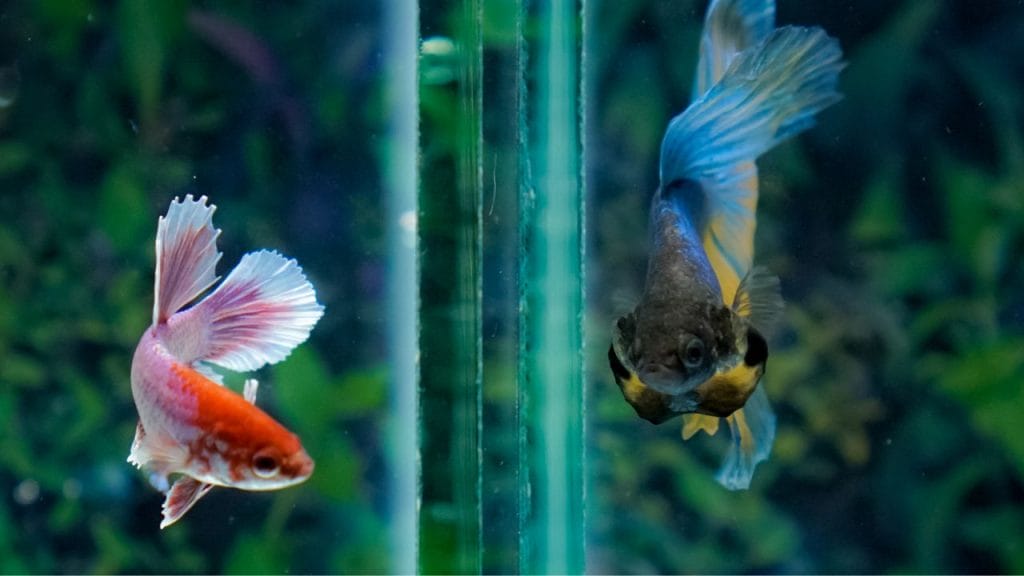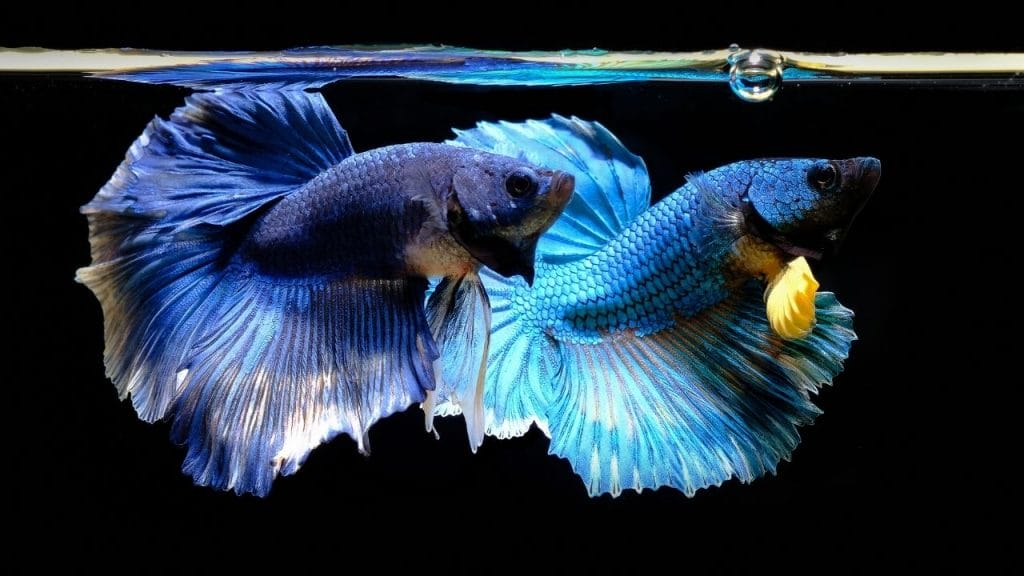How Often Should You Change Water In A Betta Tank?

Changing water is crucial for any aquarium fish. Many fish keepers have the misconception that bettas are hardy and they don’t need regular water change. This is absolutely wrong. No matter how hardy a fish is, it can’t endure constant ammonia buildup in a confined space. So, if you are not changing water regularly, your betta fish is going to die at some point.
If the tank is less than 5 gallon, you need to change 40% to 50% water every week. For tanks bigger than 5 gallon, you need to change 20% to 30% water weekly. If the tank has proper filtration, changing 15% water every week is enough.
There are lot more to know about changing water in a fish tank. The frequency of water change actually depends on many factors. In the rest of the article, I’ll go over each of these factors in details.
How Often Do You Change Betta Water Without A Filter?
Adding a filter is a must for keeping a betta in captivity. A good filtration system can neutralize the harmful buildups in the water. Moreover, this increases the oxygen level by creating water movement at the tank surface.
When there’s a filter, you need not do much water change in your betta tank. According to expert opinion, you should clean around 50% water once or twice a week if you keep your betta without a filter. But, if you keep your betta in a 2.5-gallon fish bowl, you should change 25-30% water regularly without a filter.
Although betta fish are hardy, keeping a filter makes them thrive well. On the other hand, your betta fish will become stressed if you change the water daily. Hence, I recommend keeping a sponge filter for your betta fish tank.
Changing Betta Fish Water (Frequency)
The betta owners often remain confused by thinking about the frequency of betta water change. To reduce your hassle, I’ve made a small chart mentioning the tank size and how often you should change its water. Let’s take a quick look at this.
| Size Of The Tank | Water Change Quantity | Water Change Frequency |
|---|---|---|
| 1-2 gallon | 70-80% | Twice per week |
| 3 gallon | 50% water | Twice a week |
| 5 gallon | 50% water | once a week |
| 10 gallon | 30-40% water | once a week |
| 20 gallon | 20-30% water | Once a week |
| 50 gallon | 25% water | Every 2-4 week |
What Do You Need To Change The Water Of The Betta Tank?
You’ll need some basic stuff while changing the water of the betta tank. Let’s check out the following list of necessary components and their work.
1. Large Buckets
You may require two large buckets for changing the water of the betta tank. Firstly, you need to vacuum out the water in one bucket. On the other hand, you will need to prepare another bucket of water to refill the tank.
2. Water Conditioning Solution
When you add tap water to your betta fish tank, you have to add a water conditioning solution. This solution will remove chlorine, chloramine, and other harmful chemicals present in the water. I recommend using Tetra Betta Safe Water Conditioner.
3. Thermometer
While changing the water in your betta tank, you’ll require a thermometer. You need to keep the same temperature in the new water as the old water. Also, make sure that the temperature remains within the ideal range.
4. Gravel Vacuum Or Aquarium Siphon
To clean the gravel or substrate of the betta tank, you can use a colander. Otherwise, a gravel vacuum works as a modern solution.
The best option will be to use the aquarium siphon. You’ve to siphon out the water through the tube by up and down motion. These aquarium siphons will move out the impurities, betta feces, and other specks of dirt.
5. Dechlorinator
To make the tap water safe for your betta, you may require to use a de-chlorinator.
6. Large scrapers
When you start cleaning your dirty betta tank, you’ll need a large scraper. The algae growth can make the tank water cloudy. So, you’ve to scrape out the algae and biofilm while cleaning the tank water.
7. Test Kits
While cleaning the tank water, you must ensure keeping the new water parameters ideal. To monitor the water quality, you might need test kits.
How Do You Change The Betta Fish Water?
You can change the betta fish water in two ways. In maximum time, the betta owners change a certain amount of water. Otherwise, you can do an entire water change. Let’s see the procedures for both kinds of water change.

Partial Water Change In The Betta Tank
Step 1: Remove The Tank Cover
Firstly, you should move out the tank cover. Before removing the tank lid, you should ensure to stop the heater, light, filter, and other devices. Then, you can also separate the décor items if you want to clean them.
Step 2: Throw Out Water
You should remove 25-30% water with the help of an aquarium siphon. Drag the siphon across the substrate or gravel of the tank. You can remove the dirty water through the other end of the suction siphon.
Step 3: Prepare The New Water
Then, you need to take another clean bucket. In this bucket, you have to prepare the new water before adding it to the betta tank. You must remember not to add tap water directly to the tank.
While using tap water, you should not forget about using a water conditioner. In addition, you should match the temperature of the new water with the temperature of the unfiltered water. Don’t forget to check whether the new water fulfills all conditions of ideal betta water parameters or not.
Step 4: Refill The Tank
In the final stage, you can refill the tank with the prepared new water. Pour the new water slowly. Besides, put down all décor items and stuff taken out for cleaning. Finally, cover the tank with the tank lid.
Full Water Change In The Betta Tank
Step 1: Prepare The New Water
Before starting the procedures, you should prepare the new water in a large bucket. Take the same amount of water that you are going to pour out of the betta tank.
Make sure to keep the water as warm as the same temperature as the water of the betta tank. However, the ideal temperature for a betta is around 78-80 degrees Fahrenheit.
Also, you must check whether the water parameters remain ideal or not. If you use tap water, you should dechlorinate the water first.
Step 2: Transfer Your Betta
Now, you should transfer your betta before starting to clean the tank. Transfer your betta to the bucket of newly prepared water using a fishnet. Before keeping your betta, you should acclimate the betta to the new water first.
Step 3: Pour Out The Old Water
Then, you have to pour out the old water from the tank. You can do this using an aquarium siphon. Otherwise, you can take out the water in a small mug or bowl.
Step 4: Clean The Tank
Before refilling the tank, you need to clean your betta tank thoroughly. You should clean the walls and surface of the tank using only a soft sponge and water. Besides, you should scrub the rocks and other décor items.
Take out the gravel to clean it well. You should remove the fish feces, uneaten foods, debris, and other wastes. However, you should not use soap or detergent while cleaning your betta tank.
Step 5: Setup The Tank
When you’re done with cleaning, you should set up the tank again. You can also clean the filter media before setting up the tank.
Step 6: Refill Half Of The Tank
Then, you can start refilling the betta tank. Pour around half of the tank so that your betta can swim comfortably.
Step 7: Bring Back Your Betta
Now, you should gently bring back your betta to the partially filled tank. Make sure to remain gentle while transferring your betta.
Step 8: Fill The Rest Of The Tank
Then, fill the rest of the tank with the remaining prepared water. This time, you should pour the water slowly as there is already betta fish in the tank. You can also use a siphon hose to add the water.
Relation Between Tank Size & Water Change
In the second paragraph, I have mentioned to do larger water change in smaller tanks. Why is that?
To understand the relation between water change and the size of the tank, we actually need to know why we are changing water in the first place. Let’s start with the basics.
When we keep any fish in the aquarium, naturally it produces waste. Also, we regularly feed the fish. Some food particles remain uneaten. All these organic materials create ammonia in the aquarium.
This ammonia is lethal for the fish. Fortunately there is a already a strong army in the aquarium to tackle this ammonia. The army is none other than the Beneficial bacterial colony.
The beneficial bacterial colony turns Ammonia into Nitrite and Nitrite into Nitrate. This is what the process looks like:
Ammonia -> Nitrite -> Nitrate
Nitrate is the end product. Now, nitrate is far less harmful than Ammonia. However, when nitrate starts to build up with time, it can slowly make the environment toxic for the fish. If no actions are taken, the nitrate will once get so high that it can kill the fish.
That’s why we perform regular water changes to keep the amount of Nitrate in check. When we fill in the tank with new & fresh water, it lowers down the amount of Nitrate, thus keeping the tank environment safe for all the fish.

So, Why Smaller Tanks Need Larger Water Change?
If the tank is smaller (let’s say less than 5 gallons), then the Nitrate will very quickly build up to the amount that is toxic for the fish. On the other hand, for a larger tank, it will take more time for the Nitrate to become toxic.
Let’s say within 1 week your tank produces 10 milligram nitrate (just an assumption).
Now, if your tank can hold 19 liter water (5 gallon), the concentration of nitrate after 1 week will be 0.5 milligram per liter (ppm).
On the other hand, if your tank can hold 38 liter water (10 gallon), the concentration will reduce down to 0.26 milligram nitrate per liter water (ppm).
As you can see, with the same growth rate of nitrate and after the same period of time, the concentration of nitrate can be much higher in a smaller tank compared to a larger tank.
That’s why it is recommended to do larger water changes in smaller tanks aka tanks that are smaller than 5 gallon.
Factors That Control The Frequency Of Water Change
There are many factors that can affect the frequency of water change in your tank. When you are determining how often to change water in a betta tank, you’ll need to consider all of these factors.
Is The Tank Cycled Or Not?
If the tank is not cycled, you’ll need to change water more often. Why? Because an uncycled tank doesn’t have an established beneficial bacterial colony. So, there is nothing to tackle the ammonia in the tank.
As a result, if you are not frequent with the water changes, the ammonia will soon build up and create a toxic environment for the betta.
As bettas are hardy, many people prefer not to cycle the tank before putting the betta. Though this is not recommended, it can work if you have a large tank (larger than 10 gallon) and only the betta living in it. It will be better if you also have real plants in the tank as plants can help to tackle the ammonia.
Now, I’ve already mentioned ammonia is dangerous for any water being. That’s why, until the tank is properly cycled, we’ll need to do more frequent water changes, preferably 15% everyday for the first 2 weeks.
Are There Other Tank Mates?
This is a very important yet simple concept to understand for every fish keeper. If an aquarium has lots of fish, then it will produce lots of bio load (meaning fish waste). Lots of bio load will in turn create lots of ammonia.
This is simply the equation:
Bio load from A 10 gallon tank with 5 fish < Bio load from a 10 gallon tank with 10 fish
So, the more fish you have, the more bio load they will create, as a result, the more frequent you’ll have to be with the water change. If you don’t want to make water change more than once per week, then you’ll have to perform a larger volume water change if the bio mass (number of living creatures in the aquarium) is heavy.
Is There A Proper Filtration?
Every aquarium needs to have proper filtration system. Many people keep betta in little bowls without any type of decent filtration. They think that bettas are hardy enough to live in a small bowl for the rest of its life.
This makes me extremely angry and frustrated. Suppose I have shoved you into a cupboard. I am giving you meals 2 times a day.
Now will you be alive after 1 month? Probably yes.
Will you be happy after staying in the cupboard for 1 month? DEFINITELY NO!
So, please don’t keep bettas in little bowls with no filtration. If there is no proper filtration, the tank will have no beneficial bacterial colony to tackle the growth of deadly ammonia.
As a result, you may need to change water daily or every other day (depending on the size of the tank) to keep the water relatively safe for the betta.
On the other hand, if you have a proper filtration, you’ll have an army of bacteria on your side to fight the deadly ammonia. So, in that case, you can push back the water change frequency to once a week.
Does The Tank Have Real Plants?
I have already mentioned why we do water changes. Remember about the nitrates? The beneficial bacterial colony eats Ammonia as food and eventually turns it into Nitrate.
Now, nitrate is a great food for plants. Plants absorb nitrate as fertilizer to grow. So, if you have real plants in the betta tank (which is recommended), then the plants will also help you to absorb Nitrate. In that case, you may push the water change frequency to once every 10 or 12 days depending on the amount of plants you have.
I have seen many betta fish keepers keeping their betta in a ‘no filter’ heavily planted tank for years. The betta stayed happy and thrived. The reason it worked because the plants worked as the filter and absorbed Nitrate.
Plants also produce oxygen, which of course creates a more comfortable environment in the tank for the betta.
Does The Tank Have Substrate?
If the tank has a good layer of substrate (sand, aqua soil, gravel, etc.), then it may need more frequent water changes than a bare bottom tank. It is because, the substrate helps to trap the uneaten foods, fish waste and all other organic matters.
These organic matters decay over time and give rise to ammonia. They also form gas pockets within the substrate which can be dangerous for the fish. This type of problem doesn’t occur in a bare bottom tank.
What Are You Feeding The Betta?
The food you are feeding your betta will also affect the water change frequency. If you are often feeding live foods like bloodworm, earth worm, daphnia, brine shrimp, etc., then these will quickly deteriorate the quality of the water.
In that case, you may need to do more frequent water changes in order to keep the water quality pristine.

Betta Fish Died After Water Change? Here’s Why
The most probable reasons for your betta fish dying after a water change are:
- You haven’t treated the water with a water conditioner. If you are using tap water directly to the betta tank, then it can be deadly for the fish. Tap water contains chlorine and chloramine (in some areas) that are lethal for any fish. Before using them in the tank, we’ll need to treat the tap water with a good quality water conditioner (such as Seachem Prime). This water conditioner will remove the chlorine and chloramine, thus making the tap water safe for the betta.
- The temperature of the new water is either too hot or too cold than the tank water. This type of rapid temperature change can put the betta into shock and kill it.
- The parameters of the new water are way too off than the tank water. Though betta fish dying for this reason is very unlikely, it can happen if the parameters differ way too much from the tank water.
How Long Can A Betta Fish Go Without Water Change?
Betta fish can go for weeks without water change if the tank is large, has proper filtration and heavy plants. Also, the bio mass needs to be as low as possible (preferably only the betta).
However, that doesn’t mean we should actually neglect water change for weeks. Yes, your betta might survive if you don’t change water regularly, but that will be inhumane for the betta as it will live in a toxic environment.
Can You Use Tap Water To Refill The Betta Tank?
You can use tap water to refill the betta tank only after it is treated with a good water conditioner. Other wise, the tap water may contain chlorine and chloramine which will be deadly for any fish.
Why You Shouldn’t Change More Than 50% Water?
If you change too much water in one go, then several problems will arise:
- As more than half of the tank will be refilled by new water, it can set off the parameters. This can have an impact on the beneficial bacterial colony and destroy it. If the beneficial bacterial colony gets destroyed, it will be a disaster for your betta tank. The tank will need to be cycled again.
- If the parameters get set off too much, it can also have an adverse affect on the betta fish. As a result, the betta fish can go into shock. Sudden shock is not good for any fish.
Can You Set Up A No Water Change Betta Tank?
You might know that one of the most significant rules of betta maintenance is to change their tank water regularly. But, recently, a new concept of no water change betta tank has become pretty popular among hobbyists.
You can set up a no water change betta tank. For this, you need to follow some conditions.
When you look at the natural habitation of betta, you may notice the natural balance system. In the wild, there’re more plants present than the amount of food waste. As a result, there requires no need to change water for a betta in the wild.
You can apply the same trick in your betta aquarium to set up a no-water change tank. For this, you’ll require a large tank of at least 10 gallons.
Secondly, you should introduce lots of hardy and fast-growing plants in the tank. But, do not overstock the betta tank.
However, you should remember that the main job of no water tank is done by the plants. Hence, you should regularly trim the plants to fasten their growth. Ensure proper lighting for the plants.
The next thing to provide is a deep substrate. It’ll help create an anaerobic zone for your betta. Since you need to balance food waste and nitrogen gas, you should maintain optimal feeding to your betta. Try to make minimal waste in the betta tank.
Setting a no water change betta tank with equilibrium condition is pretty hard. You’ve to follow the conditions strictly. For safety, you can add a basic filter for your betta tank.
Do Betta Fish Need A Water Conditioner?
The betta fish require a water conditioner to thrive well in the tap water. Besides, this water conditioner becomes essential when you add tap water.
You might know that tap water contains several harmful chemicals like chlorine, chloramine, and many types of heavy metals. On the other hand, betta fish can’t survive in such water. To remove these harmful contents, you must treat the tap water with a water conditioner.
Can You Do Full Water Change In Your Betta Tank?
There are two basic ways to change the water of your betta tank. You can do a partial water change. Otherwise, there is an option to do a full-water change in your betta tank.
Changing full water is a stressful idea for your betta fish. When you do a 100% water change, you’ll remove the beneficial bacteria present in the tank. Moreover, it becomes pretty hard for your betta to acclimate to the new water. But, you can do a complete water change under several conditions.
If the tank is too dirty, you may need to throw out the entire water of the tank. But, the frequency of changes depends on the size of the betta tank.
Sometimes, the beginners love to keep single betta fish in a pint jar that may contain only around 500 ml of water. In such a case, you have to do a full water change daily. On the other hand, if you keep your betta fish in a one-gallon tank, you may do a 100% water change once a week.
How Often To Clean Betta Fish Bowl?
If you keep your betta in a fish bowl, the water of the bowl gets dirty pretty quick. The wastes of betta, uneaten foods, and other decaying stuff make the little amount of water toxic.
When the betta fish bowl has a filter, the experts suggest cleaning the bowl once a week. But, the bowl should be of 15-20 liter capacity. Moreover, the condition is applicable when there is only one betta in the fish bowl.
If you do not add a filter in the fish bowl, you’ve to change the water more than in the usual tanks. Cleaning the bowl 2-3 times a week may be sufficient for a betta fish bowl that does not have any filter.
The small betta fish bowl of 2 liters requires daily cleaning. If the bowl is 6 liters, you should change the water three times a week.
However, when you change the water of a betta fish bowl, you should replace your betta in the new water of the same temperature. Do not forget to acclimate your betta fish before introducing it into the new water. Otherwise, your betta may die due to stress.
How To Keep Betta Fish Water Clean?
Keeping betta fish water clean is all about regular maintenance. Despite that, you can follow a few methods to reduce cleaning the tank. Let’s check out the following ways how you can keep betta fish water clean.
1. Get A Larger Tank
A small trick to keep betta water clean is to choose a larger tank. No wonder that smaller tank gets dirty fast. You need to clean the water of such a tank more often than in a larger tank.
Moreover, smaller tanks remain overstocked with a betta and other required things. Hence, the presence of ammonia and nitrite reaches a toxic level soon.
In the case of a larger tank, the quantity of water remains more than a small tank. As a result, it takes some for the water parameters to get worse in a larger tank. So, you’ll require less water change when you get a larger tank for your betta.
2. Keep Fewer Fish
Keeping fewer betta fish in a larger tank means less maintenance for the owners. There is no doubt that fewer fish means less production of natural wastes.
It’s pretty normal to expect wastes of betta fish fecal matter, leftovers, discarded scales, etc. If you keep tank-mates of betta in the tank, there will be more waste in the tank. To keep the betta tank water clean, you should keep fewer betta and their tank mate in the tank.
3. Regular Aquarium Cleaning
To keep the betta tank water clean, you should perform regular cleaning and maintenance. Scrub the tank wall to remove the algae growth from the tank. Besides, you should vacuum the substrate or gravel of the betta tank.
Do not forget to clean the filter cartridges once in two weeks. Otherwise, you’ve to replace the filter media. If you do not clean the betta tank regularly, there will be a faster buildup of ammonia, nitrates, and other harmful contents.
4. Not Overfeeding
Another prime reason for poor water quality is the uneaten foods of betta. Betta fish do not require much food at one time. When the leftovers of betta remain at the bottom of the tank, these uneaten foods start decaying gradually.
As a result, the tank water will get cloudy, and its parameters get changed. So, you must not overfeed your betta if you want to keep betta fish water clean for a long time. Moreover, after feeding your betta, you should remove the leftovers.
5. Get Live Plants
You can introduce live plants into the ecosystem of the betta in captivity. These aquarium plants can absorb carbon dioxide, ammonia, nitrite, and many harmful components.
Moreover, the live plants will replace the nitrates with oxygen in your betta tank. So, keeping live plants can help you a bit to keep the tank water clean.
6. Remove Rotten Plants
Although keeping plants is beneficial to the betta tank, these demand proper maintenance too. If you notice rotten leaves or plants in the tank, you should remove these as fast as possible.
These rotten or decaying plants play a significant role in ammonium buildup that turns into nitrite. So, the tank water will ultimately get toxic to your betta.
7. Add A Larger Filtration System
If you want to keep betta fish water clean, you can apply the trick of adjusting a larger filter. It will reduce your hassle of changing water and maintenance.
The filtration system works with the help of beneficial bacteria. These bacterias will neutralize ammonia, nitrite, and so on.
So, if your betta fish tank holds the capacity of 10 gallons, you can add a 20-25 gallon filter. Otherwise, a normal filtration system with the same tank capacity can work too.
8. Introduce Snails Or Shrimp
You might know that snails and shrimp are known as clean-up crews. Since these are scavengers, they clean up the tank by eating decaying elements, uneaten foods, etc. So, introducing snails or shrimp can help you a lot to keep your betta tank clean.
About Author
Hello, I’m Muntaseer Rahman, the owner of AcuarioPets.com. I’m passionate about aquarium pets like shrimps, snails, crabs, and crayfish. I’ve created this website to share my expertise and help you provide better care for these amazing pets.
Disclaimer
This site is owned and operated by Muntaseer Rahman. AcuarioPets.com is a participant in the Amazon Services LLC Associates Program, an affiliate advertising program designed to provide a means for sites to earn advertising fees by advertising and linking to Amazon.com. This site also participates in other affiliate programs and is compensated for referring traffic and business to these companies.

